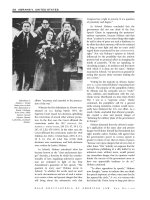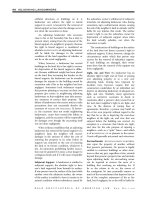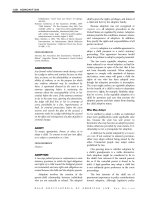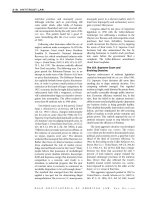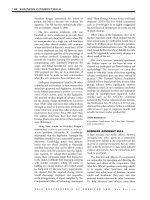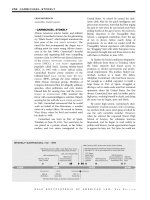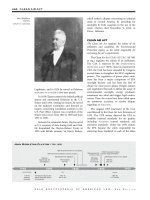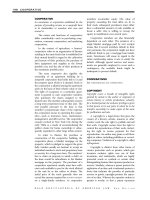Gale Encyclopedia Of American Law 3Rd Edition Volume 5 P5 potx
Bạn đang xem bản rút gọn của tài liệu. Xem và tải ngay bản đầy đủ của tài liệu tại đây (268.02 KB, 10 trang )
Under a number of game laws, it is a penal
offense to kill or take certain types of game in
certain seasons of the year or without a license.
A hunter is required to exhibit a license when
properly called on to do so, and it constitutes a
legal violation if the person cannot do so.
In a situation where an individual has
lawfully obtained possession of game—enclosing
and caring for them as
DOMESTIC animals—the
person can kill one or more of them if necessary
for care and management or for humane
purposes. In addition, an individual might be
justified in killing game in violation of the law if
it were necessary for the protection of persons or
property. It sometimes constitutes an offense to
export game beyond the limits of the nation or
state in which it was killed or captured, to ship it
for sale in a certain manner, or to absent certain
information upon the package.
The United States has entered into treaties
with other countries, including Great Britain
and Mexico, for the protection and preservation
of migratory birds and game animals. It
constitutes an offense to violate statutes that
were enacted to implement such treaties. For
example, a regulatory statute might limit the
number of birds that can be killed by any
individual each day, and it would be an offense
to exceed such limit.
The
FEDERAL government, subject to the
CONSENT of the state, can establish a game refuge
for the protection of game and migratory birds
and proscribe all hunting in the vicinity. The
U.S. Fish and Wildlife Service is administered
by the
INTERIOR DEPARTMENT, to conserve and
preserve fish and game in wildlife refuges and
game ranges.
CROSS REFERENCES
Endangered Species Act; Fish and Fishing.
GAMING
Gaming is the act or practice of gambling. It
is an agreement between two or more individuals
to play collectively at a game of chance for a stake
or wager, which will become the property of
the winner and to which all involved make a
contribution.
Since the early 1990s,
GAMING laws have been
in a constant state of flux. Regulation of gaming
is generally reserved to the states, but the U.S.
Congress became involved in it in 1988 with the
passage of the Indian Gaming Regulatory Act
(Gaming Act) (Pub. Law. No. 100-497, 102 Stat.
2467 [25 U.S.C.A. § 2701 et seq.][Oct. 17,
1988]), which brought tribal gaming under the
regulation of state and
FEDERAL governments.
Before the 1990s most gaming was illegal in
a majority of states. Since the passage of the
Gaming Act, many state legislatures have
approved gaming in a variety of forms. Some
states still outlaw all but charitable gambling,
but most have expanded their definition of
legal gaming operations to promote economic
development.
The
LEGAL HISTORY of gambling in the United
States is marked by dramatic swings between
PROHIBITION and popularity. In colonial times,
games of chance were generally illegal except for
state and private lotteries. Other gaming was
considered a sin and not fit for discussion in
polite society. In the early nineteenth century,
the popular belief changed from seeing gaming
as a sin to seeing it as a vice. Gamblers were no
longer considered fallen in the eyes of God but
were now seen as simply victims of their own
weaknesses.
Gaming came under renewed attack during
the presidency of
ANDREW JACKSON (1829–1837).
Part of the so-called Jacksonian morality of the
period revived the view of gambling as sinful. By
1862, gaming was illegal in all states except
Missouri and Kentucky, both of which retained
state lotteries.
ILLUSTRATION BY GGS
CREATIVE RESOURCES.
REPRODUCED BY
PERMISSION OF GALE,
A PART OF CENGAGE
LEARNING.
Hunting Participation in 2006
Participants (in millions)
Big game
Small game
Migratory birds
Other animals
024681012
4.8
2.3
1.1
SOURCE: U.S. Fish and Wildlife Service, 2006 Nationa
l
Survey of Fishing, Hunting, and Wildlife Associated
Recreation, October 2007.
10.7
GALE ENCYCLOPEDIA OF AMERICAN LAW, 3RD E DITION
28 GAMING
After the Civil War, legal gaming experi-
enced a brief renaissance, only to fall out of
favor again in the 1890s. At this point, it was
outlawed even in the western territories, where
card games such as poker and blackjack had
become a regular
DIVERSION in frontier life. By
1910, the United States was again virtually free
of legalized gaming. Only Maryland and
Kentucky allowed gambling, in the sole form
of horse race betting.
In 1931 Nevada re-legalized casino gaming.
Many states followed this lead in the 1930s by
legalizing pari-mutuel betting, wherein all bets
are pooled and then paid, less a management
fee, to the holders of winning tickets. In 1963
New Hampshire formed the first
STATE LOTTERY
since the 1910s. By the 1990s gaming was the
largest and fastest growing segment of the U.S.
entertainment industry. In 1992, for example,
U.S. citizens spent approximately four times
more on gaming than on movies. Gaming is still
illegal in some states, but most states have at
least one form of legal gambling, most com-
monly a state-run lottery. In fact, instead of
prohibiting gaming, many states now actively
promote it by sponsoring lotteries and other
games of chance.
Gaming laws vary from state to state. Idaho,
for example, declares that “gambling is contrary
to public policy and is strictly prohibited except
for” pari-mutuel betting, bingo and raffle games
for charity, and a state lottery (Idaho Const. art.
III, § 20). Like lotteries in other states, the
purpose of the one in Idaho is to generate
revenue for the state. The lottery is run by the
Idaho State Lottery Commission, which over-
sees all aspects of the game, including expenses
and advertising. As of 2009, 43 states permit
lotteries.
In addition to lotte ries, some states with
direct access to major river syste ms or lakes
expanded their venues for gaming to include
riverboats. On July 1, 1989, Iowa became
the first state to authorize its Racing and
Gaming Commission to grant a license to
qualified organizations for the purpose of
conducting gambling games on excursion boats
in counties where referendums have been
approved. Illinois quickly followed Iowa with
its Riverboat Gambling Act (230 ILCS 10),
which went into effect on February 7, 1990.
Five more states passed legislation permi-
tting licensing for riverboat casinos: Illinois,
Indiana, Louisiana, Mississippi, and Missouri.
Some riverboat gambling vessels are perma-
nently docked while others e mbark on brief
cruises and return to their docks after several
hours of gaming, dining, and entertainment for
passengers.
Alabama is one of the few states that prohibit
all gambling except for charitable gaming.
Alabama maintains no state lottery and punishes
gambling through criminal statutes. Under
the Code of Alabama, sections 13A-12-24 and
13A-12-25 (1975), the possession of gambling
records is a class A misdemeanor, which carries a
penalty of not more than one year in
JAIL or a
$2,000 fine, or both.
Nevada is the most permissive state for
gambling. Its public policy of gaming holds that
“[t]he gaming industry is vitally important to the
economy of the state and the
GENERAL WELFARE of
the inhabitants” (Nev. Rev. Stat. § 463.0129).
Nevada statutes allow the broadest range of
gaming activities, including pari-mutuel betting,
betting on sports competitions and other events,
and the full panoply of casino games. Gambling
is heavily regulated by the Nevada Gaming
Commission, and a wide range of criminal
statutes are designed to ensure cooperation with
the regulations of the commission.
Gaming
LOTTERY SALES BY GAME, IN 2007
Sales (in billions of dollars)
Game
I
ns
t
a
n
t
Lo
t
to
Th
r
e
e- or
fou
r
-d
i
g
it
O
th
er
a
SOURCE: TLF Publications, Inc., 2008 World Lottery
Almanac.
0
30
25
20
10
15
5
$29.7
$10.0
$9.1
$3.6
a
Includes break-open tickets, spiel, Keno, video lottery, etc.
ILLUSTRATION BY GGS
CREATIVE RESOURCES.
REPRODUCED BY
PERMISSION OF GALE,
A PART OF CENGAGE
LEARNING.
GALE ENCYCLOPEDIA OF AMERICAN LAW, 3
RD E DITION
GAMING 29
New Jersey is another active promoter of
gaming. In 1976, New Jersey voters passed a
REFERENDUM approving casino gaming, and that
decision was codified in the Casino Control Act
(N.J. Stat. Ann. § 5:12-1 et seq.). Gaming is
limited to Atlantic City, and it does not include
betting on sports events other than horse and
dog races. However, like Nevada, New Jersey
offers the full array of casino games.
The Gaming Act divides all gambling into
three classes. Class I includes all traditional
Indian games performed as a part of, or in
connection with, tribal ceremonies or celebra-
tions. Class II is limited to bingo, pull tabs, and
card games not explicitly prohibited by the laws
of the state. Class III encompasses all other
forms of gambling, such as slot machines,
poker, blackjack, dice games, off-track betting
(where bets may be placed by persons not at the
race track) and pari-mutuel betting on horses
and dogs, and lotteries.
An Indian tribe may operate a class I game
without restrictions. It may offer class II games
with the oversight of the National Indian
Gaming Commission, and class III games only
if it reaches an agreement with the state in
which it resides.
The Gaming Act provides that Native
American tribes may operate high-stakes casi-
nos only if they reach an agreement with the
state in which they reside. Under the act, a
state is required to enter into
GOOD FAITH
negotiations with a federally recognized tribe
to allow class III gaming that was legal in the
state before the negotiations began. For exam-
ple, if a state has legalized blackjack b ut not
poker, blackjack is available for negotiations
but not poker. Furthermore, when a state
approves a new f orm of gambling, the state
must make the new game available in negotia-
tions with native tribes.
Native American groups have criticized the
Gaming Act as interferin g with tribal
SOVER-
EIGNTY
. Indeed, a primary purpose of the act
was to reconcile state interests in gaming with
thoseofthetribe.Beforetheact,someNative
American tribes ran sizable gambling opera-
tions on their land without regulation by the
federal or state governments. Nevertheless,
gaming has become a major source of income
for many Native American tribes. As of 2009,
there are approximately 400 Native Americ an
gaming establishments operated by about 220
federally recognized tribes.
The Gaming Act has also created opposition
in some states that seeks to minimize gambling
within their
BOUNDARIES. Maine, for example,
refused to give the Passamaquoddy tribe a license
to conduct class III gaming operations on tribal
land in Calais, near the Canadian border. The tribe
sued the state for the right to conduct the high-
stakes gaming. However, several years earlier,
Maine had given land to the tribe in exchange for
the tribe’s agreement to submit to state
JURISDIC-
TION
.InPassamaquoddy Tribe v. Maine (75 F. 3 d
784 [1st Cir. 1996]), the First
CIRCUIT COURT of
Appeals ruled against the tribe. The court noted
that Congress had been aware of Maine’s
agreement with the tribe and that Congress could
have added to the Gaming Act, but chose not to,
language making the act applicable to the state of
Maine. According to the court, the gaming statute
did not erase the 1980 agreement between the
tribe and the state, and Maine had the right to
refuse the tribe’srequest.
FURTHER READINGS
American Gaming Association. Available online at www.
americangaming.org (accessed July 26, 2003).
Campion, Kristen M. 1995. “Riverboats: Floating Our Way
to a Brighter Fiscal Future?” Seton Hall Legislative
Journal 19.
Rose, I. Nelson. 1993. “Gambling and the Law—Update
1993.” Hastings Communications and Entertainment
Law Journal 15.
CROSS REFERENCES
Native American Rights; State Lottery.
Patrons of this South
Dakota casino can
play blackjack and
slot machines.
Regulation of gaming
is generally reserved
to the states.
DEADWOOD GULCH
RESORT AND CASINO.
DEADWOOD, SOUTH
DAKOTA.
GALE ENCYCLOPEDIA OF AMERICAN LAW, 3
RD E DITION
30 GAMING
v
GANDHI, MOHANDAS
KARAMCHAND
Widely known as Mahatma or “Great Soul”,
MOHANDAS KARAMCHAND GANDHI is considered one
of history ’s great political pacifists. He is
remembered nearly as much for his austere
persona (frail, bespectacled, clad only in a
draped loincloth) as his political achievements.
Gandhi played a major role in leading India to
INDEPENDENCE from British rule, in 1947, follow-
ing
WORLD WAR II.
The quintessential nonviolent activist,
Gandhi dedicated his life to political and social
reform. His teachings and example were to later
influence such leaders as MARTIN LUTHER KING Jr.
and Nelson Mandela, who also utilized passive
resistance and conversion rather than confron-
tation to bring about social change. Gandhi’s
signature marks were what he called Satyagraha
(the force of truth and love) and the ancient
Hindu ideal of Ahisma, or nonviolence toward
all living things.
Gandhi was born in western India in 1869.
Just 11 years earlier (in 1858), Britain had
declared India a loyal colony. The young
Gandhi completed a British-style high school
education and was greatly impressed with
British manners, genteel culture, and Christian
beliefs. He aspired to become a
BARRISTER at
law, but was proh ibited from doing so by the
local head of his Hindu caste in Bombay. His
first act of public defiance was his decision to
assume the role of an “ ou tcaste” and leave for
London to study law.
While studying in England, Gandhi first read
(and was inspired by) the Bible and the Bhagavad
Gita, a Hindu religious poem. The story of the
Sermon on the Mount in the Christian New
Testament stirred in him an interest in passive
resistance, and he also became intrigued with the
ethical basis of vegetarianism after befriending a
few enthusiasts at a local restaurant. He would
later use dietary fasting as a means to draw
attention to social causes.
But it was an incident in 1893 that put into
motion Gandhi’s focused role in history. While
on a legal assignment in South Africa, he was
traveling on a train near Johannesburg when he
was ordered to move from his first-class
compartment to the “colored ” car in the rear
of the train. He refused. At the next station, he
was thrown from the train and spent the night
at the station. The experience triggered his
lifelong dedication to
CIVIL RIGHTS and to the
improvement of the lives of those with little
political voice.
By 1906 he had taken on his first major
political battle, confronting the South African
government’s move to fingerprint all Indians
with publicized passive resistance. His efforts
failed to provoke legal change, but he gained a
wider following and influence.
Returning to India in 1915, Gandhi began a
succession of political campaigns for indepen-
dence in his homeland. He orchestrated wide-
spread boycotts of British goods and services,
and promoted peaceful noncooperation and
nonviolent strikes. He is widely remembered
for his 1930 defiance of the British law forbid-
ding Indians to make their own salt. With 78
followers, he started on a march to the sea. Soon
more than 60,000 supporters were arrested and
jailed, but Britain was forced to negotiate with
the gentle and powerful little man. Gandhi
himself was arrested several times by the British,
who considered him a troublemaker, and all
total, spent about seven years of his life in
JAIL.
Although his unrelenting efforts played a
major role in India’sindependencein1947,the
victory was bittersweet for Gandhi. Britain
announced not only the independence of India,
but also the creation of the new Muslim state of
Pakistan.Withallhis power and influence,Gandhi
Mohandas Gandhi.
TIME LIFE PICTURES/
GETTY IMAGES
AN UNJUST LAW IS
ITSELF A SPECIES OF
VIOLENCE
.ARREST
FOR ITS BREACH
IS MORE SO
.
—MOHANDAS GANDHI
GALE ENCYCLOPEDIA OF AMERICAN LAW, 3RD E DITION
GANDHI, MOHANDAS KARAMCHAND 31
could not undo the years of hatred between the
Hindus and Muslims. On January 30, 1948, while
arriving for evening prayers, he was gunned down
by a Hindu fanatic who blamed the formation of
Pakistan on Gandhi’s tolerance for Muslims.
Gandhi was 78 at his death.
The legacy of Ghandi, and his call for
“conversion, not coercion,” spread worldwide.
Passive resistance, peace marches, sitdown
strikes, and silent noncooperation became com-
mon means of nonviolent activism through
much of the latter twentieth century, especially
influencing demonstrators during the civil rights
and
VIETNAM WAR eras. Governmental entities
accustomed to punishing violent protesters were
forced to revamp their response to demonstra-
tions in which the only violence was coming
from police or guards. The U.S. Supreme Court
was inundated with cases clarifying the limita-
tions on
FIRST AMENDMENT rights of speech and
association. To this day, passive resistance
remains a principal form of protestation for
those seeking attention for their cause(s).
FURTHER READINGS
Hay, Stephen. 1989. “The Making of a Late-Victorian
Hindu: M. K. Gandhi in London, 1888–1891.” Victori-
an Studies (autumn).
McGeary, Johanna. 1999. “Mohandas Gandhi.” Time
(December 31).
Sudo, Phil. 1997. “The Legacy of Gandhi.” Scholastic Update
(April 11).
GANGS
A gang is sometimes difficult to define, especially in
legal terms. Although gangs typically involve a
congregation of individuals, primarily young males,
certainly not all congregations or informal gather-
ings of young individuals constitute gangs. Defini-
tions of gangs or street gangs vary among the laws
governing them. Alabama law, for example, defines
a “streetgang” as, “[A]ny combination, confedera-
tion, alliance, network, conspiracy, understanding,
or similar arrangement in law or in fact, of three or
more persons that, through its membership or
through the agency of any member, engages in a
course or pattern of criminal activity.” Ala. Code
§ 13A-6-26 (2002).
The rise in gang violence since the 1980s
caused lawmakers to seek a variety of methods to
curb the formation and activities of these
GANGS.
According to statistics from the National Youth
Gang Center, more than 24,500 gangs, consisting
of more than 770,000 members, exist in about
3,330 cities in the United States. Congress spends
as much as $20 billion per year in health care
costs treating victims of gunshot wounds, and
many of the incidents involving guns also involve
street and other types of gangs.
Congress, state legislatures, and municipal
governments have responded to the growing tide
of gangs by considering a variety of bills
addressing gang violence. Although efforts at
the
FEDERAL level have largely been unsuccessful,
many states and municipalities have enacted laws
designed to deter gang-related violence. Several
of these statutes and ordinances have been
fashioned as anti-loitering statutes, which often
raise
FIRST AMENDMENT concerns. The U.S. Sup-
reme Court in 1999 made it more difficult for
municipalities to draft gang loitering ordinances
ILLUSTRATION BY GGS
CREATIVE RESOURCES.
REPRODUCED BY
PERMISSION OF GALE,
A PART OF CENGAGE
LEARNING.
Demographic Profile of U.S. Youth Gang Members, in 2004
a
Sex Race Age
Female
6%
SOURCE: U.S. Department of Justice, Office of Juvenile Justice and Delinquency Prevention, Juvenile Offenders and
Victims: 2006 National Report.
Male
94%
Hispanic
49%
White
8%
Other
1%
Black
37%
Asian
5%
a
760,000 total youth gang members.
Juveniles
(under 18)
41%
Young adults
(18 or older)
59%
GALE ENCYCLOPEDIA OF AMERICAN LAW, 3RD E DITION
32 GANGS
when it found that an ordinance such as this in
the city of Chicago was unconstitutional. City of
Chicago v. Morales, 527 U.S. 41, 119 S. Ct. 1849,
144 L. Ed. 2d 67 (1999).
Background
Activities of gangs predate the formation of the
United States, though the common perception
of these gangs has changed over time. The level
of violence among street gangs is a relatively
new phenomenon. Because different organiza-
tions and individuals define the term gang
differently, accurate statistics are often difficult
to compile. Many of the crimes committed by
gangs are violent crimes, including
HOMICIDE.
Moreover, many of the gang members are
juveniles or young adults.
According to the 1999 National Youth Gang
Survey, 90 percent of gang members are male.
Seventy-one percent of these members are
between the ages of 15 and 24, and 16 percent
are age 14 or under. About 79 percent of
the gang members, according to this survey, are
Hispanic or black, while only 14 percent
are white. Because of the large discrepancy in
the number of minorities, some commentators
have suggested that young minority males are
unfairly stereotyped, leading to racial profiling of
groups consisting of these young minority males.
Until the late 1980s, public and law
enforcement agencies perceived gangs as racially
and ethnically segregated, loosely organized
fighting groups. However, a 1988 study of two
major Los Angeles gangs, the Crips and the
Bloods, showed that thes e gangs had become
highly organized and entrepreneurial. These
gangs had begun to engage in drug trafficking
and had expanded their operations to multiple
cities and states. As the gangs’ interest in drug
trade increased, so too did the level of violence
perpetrated by their members. Between 1984
and 1993, the number of homicides committed
by juveniles increased by 169 percent, repre-
senting a sharp increase in the number of gang-
related crimes. Gang membership also increased
markedly during this time. Between 1989 and
1995, the number of students reporting a
gang presence at their school increased from
15 to 28 percent.
In response to the concerns caused by gang
violence, several states and cities enacted
statutes and ordinances designed to address
street crime. In 1988 California enacted the
Street
TERRORISM Enforcement and Prevention
Act (STEP Act), Cal. Pen. Code §§ 186.20 33
(2001). Since that time, at least 28 other states
have enacted similar legislation. Cities with
traditional gang strongholds, such as Chicago
and Los Angeles, enacted a series of ordinances
that enabled law enforcement to take a more
proactive approach in fighting street gangs in
those cities.
Boston, which experienced the most num-
ber of homicides in its history in 1990
DUE
in large part to gang violence, initiated a
community-based strategy designed to target
at-risk youth before they considered joining a
gang. It also developed strategies for youth
INTERVENTION and enforcement of GUN CONTROL
laws. Due to this initiative, youth homicides
dropped 80 percent from 1990 to 1995.
Similarly, Salinas, California, experien ced a
200 percent increase in the total number of
homicides from 1984 to 1994. After receiving
federal funding, the city improved it anti-gang
task force and developed a series of additional
programs. As a result of these programs, gang
related assaults decreased by 23 percent, and the
homicide rate fell by 62 percent.
Federal Law
In his 1997 state of the union address, President
BILL CLINTON requested that Congress “mount a
full-scale
ASSAULT on juvenile crime, with
legislation that declares war on gangs,” includ-
ing more prosecutions and tougher penalties.
The same year, Congress considered two bills
under the title Anti-Gang Youth Violence Act of
1997 (S. 362, H.R. 810, 105th Cong.). Despite
initial support for this legislation, which would
have provided $200 million in funding for local
programs, neither bill passed through its
respective committee.
Although Congress has been unable to enact
comprehensive anti-gang legislation, other fed-
eral law and actions of federal authorities have
been used in the effort to curb gang violence.
Federal prosecutors have relied upon the
Racketeer Influenced and Corrupt Organiza-
tions (RICO) statute to prosecute gang mem-
bers. In the 1990s the number of RICO
prosecutions against gang members more than
doubled. Federal authorities have also assisted
local law enforcement through a variety of
funding programs. For example, in February
2003, the Los Angeles City/County Community
Law Enforcement and Recovery (CLEAR)
GALE ENCYCLOPEDIA OF AMERICAN LAW, 3RD E DITION
GANGS 33
anti-gang program received $2.5 million in
federal funding for its efforts in reducing gang-
related violence.
State Law
State legislatures have approached the problems
related to gang violence through the enactment
of a number of different statutes. Due to rulings
by the courts within the various states, some
legislatures are more restricted than others in
enacting these types of legislation because of
potential violations of state
CONSTITUTIONAL
provisions.
Gang Participation A number of states pro-
scribe participation in criminal street gangs,
though these statutes vary from state to state. In
Georgia, for instance, it is unlawful “for any
person employed by or associated with a
criminal street gang to conduct or participate
[in such a gang] through a pattern of criminal
gang activity.” Ga. Code Ann. § 16-15-4 (1998).
Likewise, in Texas, a person commits an offense
“if, with an
INTENT to establish, maintain, or
participate in a combination of or in the profits
of a combination of or as a member of a street
gang, he commits or conspires to commit” one
of several crimes, including violent crimes or
distribution of controlled substances. Tex. Pen.
Code Ann. § 71.02 (Vernon 1997).
Gang Recruitment Several states make it a
crime for a person to recruit another to join a
criminal gang. In Florida, an individual “who
intentionally causes, encourages, solicits, or
recruits another person to join a criminal street
gang that requires as a condition of membership
or continued membership the commission of
any crime” commits a
THIRD DEGREE FELONY. Fla.
Stat. Ann. § 874.05 (1999). In Kentucky an
individual who solicits or entices another
person to join a criminal gang is
GUILTY of the
crime of criminal gang recruitment. Ky. Rev.
Stat. Ann. § 506.140 (2000).
Do Anti-gang Laws Violate
the Constitution?
T
he national aversion to GANGS has
sparked d ebate over
FIRST A MEND-
MENT
rights of gang members versus
citizens’ safety at home and o n the
streets. Anti-gang injunctions and the
enactment of anti-gang l oitering ordi-
nances are the two most prominent
legal
WEAPONS currently employed
against gangs. Critics of these efforts,
most notably the
AMERICAN CIVIL LIBERTIES
UNION
(ACLU), contend that these
initiatives violate the First Amend-
ment’s right of free association. Defen-
ders of anti-gang initiatives reply that
society’s rights to pea ce and qui et and
to be free from harm outweigh the gang
members’ First Amendment associ-
ational rights.
Critics reject the idea that public
safety allows the gov ernment to tell
citizens they may not associate with
each other. As long as citizens are not
commit ting a crime, the sta te cannot tell
them not to stand on a street corner
together or walk down the stre et. The
Supreme Court has recognized that
freedom of association is on par with
FREEDOM OF SPEECH and FREEDOM OF THE
PRESS
.
The Court has allowed municipali-
ties to require permits for parades, sound
trucks, and demonstrations, in the inter-
est of public order. However, the courts
have been careful not to abridge the right
of unpopular assemblies or protests.
In 1977 the largely Jewish suburb of
Skokie, Illinois, enacted three ordinances
designed to prevent a march through the
city by the American Nazi Party. The
ACLU sued the city, and a
FEDERAL court
ruled that Skokie had violated the First
Amendment by denying the Nazis a
permit to march (Collin v. Smith, 578
F.2d 1197 (7th Cir. 1978)).
Critics of anti-gang laws also argue
that just because gang members are
unpopular to a large segment of society
does not give society the right to restrict
their right to association. Why, for
example, should the
KU KLUX KLAN be
allowed to march through an African-
American ne ighborhood while persons
in that neighborhood cannot congregate
on a playground to talk or play sports?
Critics believe there are better alter-
natives to controlling illegal gang activity
than loitering laws and community
injunctions. The ACLU contends that
anti-gang injunctions do not work and
may even make things worse. The
resources of law enforcement are con-
centrated in one area, causing the shift of
criminal activity into other neighbor-
hoods. In addition, arresting a gang
member for violating a loitering ordi-
nance will not change the underlying
dynamic of gang activity in urban areas.
Critics argue that these anti-gang efforts
are a cynical, political ploy that has more
to do with creating a tough-on-crime
appearance than with effective law
enforcement.
GALE ENCYCLOPEDIA OF AMERICAN LAW, 3RD E DITION
34 GANGS
Gang-Related Apparel A number of states
permit schools to prescribe a dress code, and
several of these states specifically allow the
schools to prevent gang members from wearing
their gang apparel at the schools. For example,
under New Jersey law, “a board of education
may adopt a dress code policy to prohibit
students from wearing, while on school pro-
perty, any type of clothing, apparel, or accessory
which indicates that the student has member-
ship in, or affiliation with, any gang associated
with criminal activities.” N.J. Rev. Stat. §
18A:11-9 (1999). Tennessee law allows similar
restrictions for students in grades six through
twelve. Tenn. Code Ann. § 49-6-4215 (1998).
Enhanced Penalties for Gang-Related Activi-
ties Some states now allow courts, including
juvenile courts, to enhance the sentences of
individuals convicted of gang-related activitie s.
In Illinois, if a juvenile age 15 or older commits
an offense in furtherance of criminal activities
by an organized gang, then a juvenile court is
required to enter an order to try the juvenile as
an adult under the criminal laws of the state.
705 Ill. Comp. Stat. § 405/5-805 (1999). An
organized gang under the statute is defined as
“an association of 5 or more persons, with an
established
HIERARCHY, that encourages members
of the association to perpetrate crimes or
provides support to members of the association
who do commit crimes.”
Local Ordinances
Municipalities have enacted a variety of mea-
sures designed to curb gang violence. Some
ordinances contain provisions similar to state
statutes. For example, the city of Albuquerque,
New Mexico, enacted an anti-gang recruitment
ordinance to protect its citizens from the fear,
intimidation, and physi cal harm caused by the
criminal activities of gangs. The ordinance
provides a laundry list of offenses that are
As an alternative, critics would em-
phasize community policing, increased
resources for law enforcement, and efforts
to improve the economic status of urban
areas. They note that crime prevention
and effective enforcement of criminal laws
will do more to make a community safe
than telling a suspected gang member to
leave a street corner. In time, they believe,
both the public and law enforcement will
realize that solid, everyday police work
produces better results.
Defenders of anti-gang initiatives
contend that although First Amendment
rights should be protected as much as
possible, no
CONSTITUTIONAL right is ABSO-
LUTE
. In the case of gangs, the violence and
criminal activity in certain parts of urban
areas have reached a stage where normal
law enforcement techniques do not work.
Although the ACLU may say that individ-
ual rights must be protected, such a claim
rings hollow when a gang can take over a
neighborhood through violence and in-
timidation and yet evade law enforce-
ment. In a crisis situation, additional steps
must be taken to restore public confi-
dence in the police and local government.
Restrictinggangactivityisnotun-
constitutional, argue defenders of the
laws, because the Supreme Court has
made it clear that no group of persons has
the right to associate for wholly illegal
aims. Moreover, associations engaging in
both legal and illegal activities may still be
regulated to the extent they engage in
illegal activities. Defenders emphasize that
the mere existence of an association is not
sufficient to bring all that association’s
activities within scope of the First Amend-
ment. Therefore, nonexpressive gang
activities can be regulated.
Defenders also emphasize that
injunctions and loitering ordinances are
constitutional because they serve signifi-
cant, and often compelling, government
interests by reducing the threat to public
health and safety caused by gang activities.
They note that in the case of an
INJUNC-
TION
, gang members are free to conduct
their expressive activities outside of the
geographic area defined in the injunction.
Thus, the injunction is likely to be upheld
because it is narrowly tailored.
Though defenders believe these
anti-gang initiatives will become impor-
tant weapon s for law enfor cement, they
acknowledge the danger of guilt by
association. They believe, however, that
this problem can be avoided if law
enforcement officials adhere to consti-
tutional standards in determining who
should be subje cted to anti-gang provi-
sions. Judges must also carefully review
EVIDENCE for each DEFENDANT to make
sure the person has not been unfairly
prosecuted.
Despite criticisms leveled by the
ACLU and others, proponents of anti-
gang laws adamantly support their use.
While some of these initiatives may prove
ineffective, law enforcement should be
given the chance to test new ways of
addressing destructive elements within
their communities. Modifications can be
made, and new initiatives plotted, but
proponents insist that the law is necessary
to protect the health and safety of citizens.
FURTHER READINGS
Perez, Silvia. 2001. “Alternatives in Fighting
Street Gangs: Criminal Anti-Gang Ordi-
nances v. Public Nuisance Laws.” St.
Thomas Law Review 13 (winter): 619–40.
Smith, Stephanie. 2000. “Civil Banishment of
Gang Members: Circumventing Criminal
Due Process Requirements?” University of
Chicago Law Review 67 (fall): 1461–87.
Vertinsky, Liza. 1999. A Law and Economics
Approach to Criminal Gangs. Aldershot,
England; Brookfield, Vt.: Ashgate.
GALE ENCYCLOPEDIA OF AMERICAN LAW, 3RD E DITION
GANGS 35
considered gang crimes and prohibits indivi-
duals from recruiting members to join criminal
street gangs.
One of the most common forms of munici-
pal ordinances aimed at reducing gang activities
appears in the form of anti-loitering laws. The
use of these laws to reduc e unwan ted elements
within a city has a long history. Many cities have
enacted such laws to allow police to arrest
vagrants and others deemed to be menace s to
society. Several cities adapted these laws to apply
specifically to gang members. However, some
courts have determined that these laws are
unconstitutional either on their
FACE or as
applied to particular defendants.
Local governmental entities have also
enacted public nuisance laws designed to allow
local law enforcement to enjoin criminal
activities. Like the anti-loitering ordinances,
these laws have come under attack on a variety
of constitutional grounds.
Constitutionality of Anti-Gang Laws
Laws aimed specifically at prosecuting members
of gangs have come under attack due to a
variety of constitutional theories. Anti-loitering
laws have been challenged on some several
grounds, including First Amendment prohibi-
tions against vagueness and overbreadth,
FOURTH
AMENDMENT
proscriptions of unreasonable
searches and seizures, and constitutional provi-
sions that prevent the government from punish-
ing individuals merely because of their status.
Vagueness has been the primary reason why
the Supreme Court has determined that anti-
loitering statutes have been unconstitutio nal. In
Coates v. Cincinnati, 402 U.S. 611, 91 S. Ct.
1686, 29 L. Ed. 2d 214 (1971), the Court
determined that an ordinance prohibiting
people from assembling on a sidewalk in such
a way that it would be annoying to passersby
was unconstitutionally vague because its appli-
cation was based on sole discretion of police
officers to determine what was “annoying.” One
year later, in Papachristou v. City of Jacksonville,
405 U.S. 156, 92 S. Ct. 839, 31 L. Ed. 2d 110
(1972), the Court held that an ordinance which
encouraged arbitrary and erratic arrests was also
unconstitutionally vague. Likewise, in Kolender
v. Lawson, 461 U.S. 352, 103 S. Ct. 1855, 75 L.
Ed. 2d 903 (1983), the Court held that a
California statute that allowed police to arrest
individuals who could not show credible and
reliable iden tification and account for their
presence at a particular location was unconsti-
tutional due to vagueness.
The Chicago City Council in 1992 enacted
the Gang Congregation Ordinance that prohib-
ited loitering among criminal street gang
members at any public place. The ordinance
allowed police officers to order any group of
individuals who were congregated “ with no
apparent purpose” to disperse if the officer
believed one of the group was a street gang
member. In three years Chicago police issued
more than 89,000 dispersal orders and made
more than 42,000 arrests under the ordinanc e.
In City of Chic ago v. Morales, the Supreme
Court, per Justice
JOHN PAUL STEVENS, determined
that the ordinance was unconstitutional due to
vagueness for two primary reasons. First,
according to the Court, the ordinance failed to
provide fair notice of prohibited conduct.
Noted the Court, “It is difficult to imagine
how any citizen of the city of Chicago standing
in a public place with a group of people would
know if he or she had an ‘apparent purpose’”
under the ordinance. Accordingly, citizens, even
those who appeared in public with a gang
member, were not provided fair notice of the
type of conduct proscribed under the ordi-
nance. Second, the ordinance failed to provide
minimum guidelines for enforcement. The
determination of whether individuals were
standing around with no apparent purpose
was based on the discretion of the officer.
After the 1992 gang ordinance was declared
unconstitutional the city o f Chicago enacted a
second Gang Congregation Ordinance in 2000.
Thesecondordinanceauthorizespoliceto
command gang members to disperse when they
are con gregated on streets for the purpose of
establishing controlover certain areas of thecity.
Other efforts to curb gang violence have
been ruled constitutional. In People ex rel. Gallo v.
Acuna, 929 P.2d 596 (Cal. 1997), the city of San
Jose successfully requested an
INJUNCTION against
local gangs based on violations of state public
nuisance laws. The gang members brought suit,
challenging that both the statute and the
injunction violated the First Amendment. The
California Supreme Court determined that
neither the injunction nor the statute violated
the gang members’ associational rights and that
the gang members’ conduct qualified as a public
nuisance under the statute. Several cities in
GALE ENCYCLOPEDIA OF AMERICAN LAW, 3RD E DITION
36 GANGS
California have sought and received temporary
and permanent injunctions against local gangs
preventing the gang members from congregat-
ing i n public places.
FURTHER READINGS
Bureau of Justice Assistance. 1997. Urban Street Gang
Enforcement. Washington D.C.: Justice Department,
Bureau of Justice Assistance by the Institute for Law
and Justice, Inc.
Huff, C. Ronald. 2001. Gangs in America III. Thousand
Oaks, CA: Sage.
Strosnider, Kim. 2002. “Anti-Gang Ordinances after City of
Chicago v. Morales: The Intersection of Race, Vague-
ness Doctrine, and Equal Protection in the Criminal
Law.” American Criminal Law Review 39 (winter).
CROSS REFERENCES
Racketeering; Vagrancy.
GAOL
The old Englis h word for JAIL.
v
GARFIELD, JAMES ABRAM
James Abram Garfield was a soldier and
congressman who became the twentieth
PRESI-
DENT OF THE UNITED STATES
. His inability to
perform the duties of office following an
ASSASSINATION attempt on July 2, 1881, raised,
for the second time in U.S. history, the question
of presidential succession.
Garfield was born November 19, 1831, in a
log cabin near the town of Orange in Cuyahoga
County, Ohio. He was the fourth and final child
of Abram Garfield and Eliza Ballou Garfield.
Garfield’s father’s ancestors were am ong the
original settlers of the Massachusetts Bay
Colony. In 1827 the father carried their
pioneering spirit to Ohio, where he worked on
an Ohio Canal construction crew. By the time
Garfield was born, his father was a struggling
farmer and a founding member of the local
Disciples of Christ church. In 1833, when
Garfield was just two years old, his father died
suddenly, leaving the family in poverty.
Garfield’s mother, a descendant of an old
Rhode Island family, was a remarkable woman.
After her husband ’s death, she ran the small
family farm on her own and saw to it that
Garfield and his siblings worked hard, attended
church, and finished school.
After completing his studies at the local school
in Orange, Garfield enrolled at the Western
Reserve Eclectic
INSTITUTE (later Hiram College),
at Hiram, Ohio. He eventually went on to
Williams College, in Massachusetts. After gradu-
ating from Williams with the class of 1856, he
returned to theinstitute at Hiram and assumedthe
duties of teacher and later principal. On Novem-
ber 11, 1858, he married Lucretia Rudolph, his
childhood friend, fellow student, and pupil.
In addition to teaching and tending to the
administration of the institute, Garfield frequent-
ly served as a lay speaker in Disciples of Christ
churches throughout northern Ohio. Like many
members of his church, Garfield advocated free-
soil principles and was a firm supporter of the
newly organized
REPUBLICAN PARTY.(Free-Soilers
were opposed to the expansion of
SLAVERY in the
western states and territories.)
With his natural speaking ability, Garfield
soon found himself in the political arena. In
1859 he was elected to the Ohio state senate. As
the United States neared civil war, Garfield put
his speaking abilities to work for the Union,
recruiting men and raising troops for battle.
In the summer of 1861, he followed his
own advice and recruited a group of volunteers
from his former school. He assembled the
Forty-second Ohio Volunteer Infantry, and
served as the unit’s lieutenant colonel and l ater
colonel. Though he had no military experience,
Garfield did have a voracious appetite for
knowledge and access to books that could
guide his command. He and his men fought at
the Battle of Shiloh, in western Tennessee.
Garfield left the field when he became ill. After
recovering he returned as chief of staff under
Major General William S. Rosencrans, with
whom he fought at Ch ickamauga, Georgia.
After Chickamauga, Garfield was promoted
to brigadier general of volunteers, and he was
elected, in absentia, to a seat in the U.S. House
of Representatives. It has been suggested that
Garfield was reluctant to surrender his com-
mand and take the seat, but he acquiesced when
President
ABRAHAM LINCOLN pointed out that
brigadier generals were in far greater supply
than administration Republicans.
In December 1863 Garfield took his seat in
the Thirty-eighth Congress as the Republican
representative from the nineteenth congressio-
nal district of Ohio. When the Republicans
became the minority party in the House after
the election of 1864, Garfield and Congressman
James G. Blaine, of Maine, emerged as minority
party leaders. Garfield distinguished himself as
ALL FREE
GOVERNMENTS ARE
MANAGED BY THE
COMBINED WISDOM
AND FOLLY OF THE
PEOPLE
.
—JAMES GARFIELD
GALE ENCYCLOPEDIA OF AMERICAN LAW, 3RD E DITION
GARFIELD, JAMES ABRAM 37
